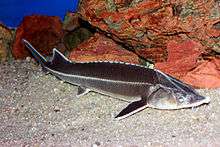Sterlet
The sterlet (Acipenser ruthenus) is a relatively small species of sturgeon from Eurasia native to large rivers that flow into the Black Sea, Azov Sea, and Caspian Sea, as well as rivers in Siberia as far east as Yenisei. Populations migrating between fresh and salt water (anadromous) have been extirpated.[1]
| Sterlet | |
|---|---|
 | |
| Scientific classification | |
| Kingdom: | |
| Phylum: | |
| Class: | |
| Order: | |
| Family: | |
| Genus: | |
| Species: | A. ruthenus |
| Binomial name | |
| Acipenser ruthenus | |
 | |
| Range of A. ruthenus Resident Extinct | |
| Synonyms[2][3] | |
|
List
| |
Due to overfishing (for its flesh, caviar, and isinglass), pollution, and dams, the sterlet has declined throughout its native range and is considered vulnerable by the IUCN.[1] Restocking projects are ongoing, and it has been introduced to some regions outside its native range, but the latter have generally not become self-sustaining.[1] Today, the majority of the international trade involves sterlets from aquaculture.[1]
Physical appearance
- The sterlet may reach 16 kg in weight and 100 to 125 cm in length, rarely exceeding a length of 90 cm.
- It is quite variable in coloration, but usually has a yellowish ventral side.
- It is distinguishable from other European species of sturgeons by the presence of a great number of whitish lateral scutes, fringed barbels, and an elongated and narrow snout, highly variable in length.
Feeding habits
The sterlet's main source of food is benthic organisms; they commonly feed on crustaceans, worms, and insect larvae.

Life history

The sterlet commonly reaches the age of 22 to 25 years. Males reach sexual maturity at 3–7 years old and females at 4–12 years old. Spawning occurs from the middle of April to the beginning of June. Females may lay from 15,000–44,000 eggs, at water temperatures preferably 12–17 °C (54–63 °F).
As pond fish
Sterlets require relatively large ponds with good water conditions, and may get entangled in plants such as blanketweed. They may require special food such as sterlet sticks, as they are unable to digest the vegetable proteins usually found in commercial fish foods.
As food
In Russia, it is held in high esteem on account of its excellent flesh, contributing also to the best kinds of caviar and isinglass
History
The sterlet also called Acipenser ruthenus, Linnaeus is the last of the five native sturgeon species inhabiting the Middle and Upper Danube River. Its population has dropped significantly, mainly due to the degradation of main habitats, spawning grounds and foraging grounds.[4]
References
- Gesner, J.; Freyhof, J. & Kottelat, M. (2010). "Acipenser ruthenus". IUCN Red List of Threatened Species. 2010: e.T227A13039007. doi:10.2305/IUCN.UK.2010-1.RLTS.T227A13039007.en.
- Froese, R.; Pauly, D. (2017). "Acipenseridae". FishBase version (02/2017). Retrieved 18 May 2017.
- "Acipenseridae" (PDF). Deeplyfish- fishes of the world. Retrieved 18 May 2017.
- Kubala, Maroš; Farský, Martin; Pekárik, Ladislav (February 2019). "Migration patterns of sterlet ( Acipenser ruthenus , Linnaeus 1758) in the Middle Danube assessed by 1 year acoustic telemetry study". Journal of Applied Ichthyology. 35 (1): 54–60. doi:10.1111/jai.13859. ISSN 0175-8659.
